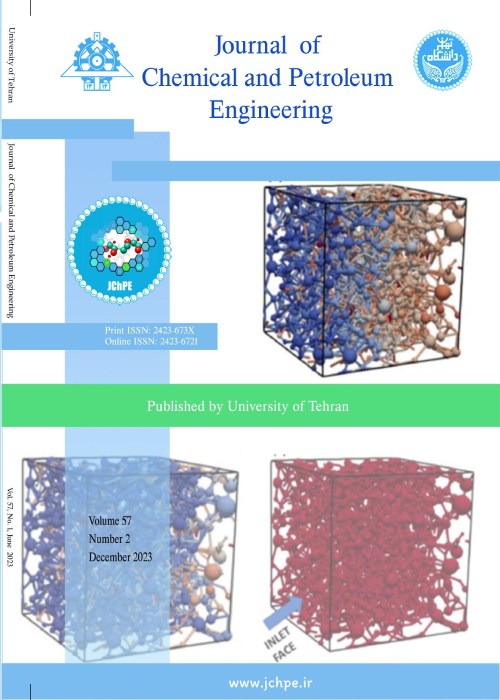فهرست مطالب

Journal of Chemical and Petroleum Engineering
Volume:49 Issue: 1, Jun 2015
- تاریخ انتشار: 1394/03/09
- تعداد عناوین: 6
-
-
Pages 1-12In the present study, a heterogeneous and homogeneous gas flow dispersion model for simulation and optimization of a large-scale catalytic slurry reactor for the direct synthesis of dimethyl ether (DME) from synthesis gas (syngas) and CO2, using a churn-turbulent regime was developed. In the heterogeneous flow model, the gas phase was distributed into two bubble phases including small and large while in the homogeneous one, the gas phase was distributed into only one large bubble phase. The results indicated that the heterogeneous gas flow model was in a better agreement with experimental pilot-plant data compared with that of the homogeneous one. Also, through investigating the heterogeneous gas flow for small bubbles as well as the large bubbles in the slurry phase (i.e.; including paraffins and the catalyst), the temperature profile along the reactor was obtained. The optimum value of rector diameter and height obtained at 3.2 and 20 meters respectively. The effects of operating variables on the axial catalyst distribution, DME productivity and CO conversion were also understudied in this research.Keywords: Dimethyl ether synthesis, Homogeneous, heterogeneous gas flow, Modelling, Slurry bubble column1
-
Pages 13-20Different recovery mechanisms are activated during the production from reservoirs. Wells sometimes are kept with the injection. Therefore the evaluation of injection indices depended on material injection, seems to be necessary. This study is going to determine the drive indices for a reservoir by making a model using Eclipse. The model consists a gas cap and aquifer, in which there is an injection well used to show water drive index. The summation of reservoir drive indices is equal to one and changing in one drive index can cause changes in the other drive indices. The relation between the all exciting drives and their effects on each other were shown by changing the production conditions in the model. A second model was simulated to know the effects of gas injection process, which is used to keep pressure and production from the reservoir. The role of effective parameters, including gas oil ratio and water cut in 3000 days, were evaluated in the second model. The optimum gas injection rate and influence of drive indices in the simulated field were obtained from the results of this work.Keywords: Aquifer, Gas cap, Indices, Injection, Recovery mechanisms
-
Pages 21-29Isothermal melt crystallization kinetics of PVDF was investigated by differential scanning calorimetry. Thin PVDF film has been fabricated by the solvent casting technique using dimethylformamide (DMF). Then, the samples were melted and subsequently crystallized in the range of the crystallization temperature (Tc) between 138 and 145 °C. The crystallization kinetics was derived from Avrami equation. Avrami parameter (n) was found in a range from 1. 5 to 2. 4 and the values of the crystallization rate parameters (k) increased with decreasing Tc. So the crystallization rate parameters suggested that PVDF crystallize slower with increasing of Tc. The Hoffman–Weeks equation has used to approximate the equilibrium melting point of PVDF which was concluded to be 182 °C. Likewise, the activation energy was estimated to be 103. 2 kJ/mol for isothermal crystallization. In this research, Lauritzen- Hoffmann theory was employed to analyze crystallization kinetics. Accordingly, regime «I» found appropriate to describe the present case of PVDF crystallization.Keywords: Crystallization kinetics, Differential scanning calorimetry, Equilibrium melting temperature, Isothermal crystallization, Poly (vinylidene fluoride)
-
Pages 31-49Bubble columns are gas- liquid contactors that are widely used in chemical and bio- chemical industries. High mixing that result in high heat and mass transfer rates are amongst their advantages. Heat transfer in a bubble column having a bundle of heaters investigated and the variation of heat transfer coefficient with variation in heaters pitch to diameter ratios in a bundle of heaters reported. The bubble column modeled in a three-dimensional in the Eulerian framework by using computational fluid dynamic simulation. It was 0.292 m in diameter and 1.5 m in height. Simulations performed for five heaters and for nine heaters in a bundle. The bubble column with a five heaters bundle was investigated in the pitch to diameter ratios of 1.5, 2 and 2.5. The bubble column with nine heaters bundle was investigated with the pitch to diameter ratios of 1.25, 1.5, 2.25 and 2.46. The range of the gas velocity was 0.0025 to 0.04 m/s. The heat transfer results show that, with decreasing the pitch to diameter ratios the heat transfer coefficient decreases. In bubble column with bundle of nine heaters at a constant superficial gas velocity, with decreasing the pitch to diameter ratio from 2.46 to 1.5 the heat transfer coefficient decreases; whereas in the pitch to diameter ratio of 1.25 heat transfer coefficient is high.Keywords: Bubble column, Bundle of heaters, CFD, Heat transfer, Hydrodynamics, Pitch to diameter ratios
-
Pages 51-62In this study the catalytic dehydrogenation of ethylbenzene to styrene was investigated in a simulated tubular sodalite membrane reactor. The high quality microporous sodalite membrane was synthesized by direct hydrothermal method and characterized by single gas permeation measurements. The performance of the prepared membrane showed high potential for application in a dehydrogenation membrane reactor (MR). The performance of the MR was evaluated using a pseudo-homogeneous model of the fixed bed that was developed in this purpose. The obtained results were evaluated in comparison with corresponding predictions for a plug flow reactor (PFR) operated at the same conditions. The modeling results confirmed the high performance of a MR over a conventional PFR. Ethylbenzene conversion and styrene yield increased about 3.45% and 8.99% respectively which is attributed to the effect of hydrogen removal from reaction side. The results demonstrate that the styrene yield in the MR is predicted to be more effective than that of in the conventional PFR.Keywords: Ethylbenzene dehydrogenation, Membrane reactor, Microporous membrane, Simulation, Sodalite membrane
-
Pages 63-78Polyamide-66(PA66)/CaCO3 micro- and nano-composites were prepared using a polymer solution method at filler loading of 0, 1, 2 and 3 weight percent. Nano-size of CaCO3 was synthesized by micro-emulsion technique. The material was characterized by XRD, SEM, FTIR and UV-VIS techniques. XRD results of composites suggested that CaCO3 particles are found in the amorphous phase of the semi-crystalline thermoplastic and α-crystalline form of thermoplastic is thermodynamically more stable than the γ-crystalline forms at room temperature. The uniform dispersion of 1, 2, and 3 wt. % surface modified micro- and nano-CaCO3within PA66 were evidenced from SEM images. FT-IR analysis confirmed the chemical structure of the PA66. Absorption peaks for all required chemical groups were showed in the FTIR spectra: N-H stretch at 3305.52 cm-1, C-H stretch at 2865.02-2936.45 cm-1, Amide-I at 1638.76 cm-1, and Amide-II at 1539.55 cm-1. UV-VIS data showed that the presence of CaCO3 particles in PA66 results in the decrease of energy-band gaps of the composites. In addition, the results showed that incorporation of CaCO3 particles increased the modulus and tensile strength of neat PA66 however decreased its yield and elongation at break.Keywords: Polyamide, 66, CaCO3 Nanoparticle, Morphology, Optical properties, Mechanical properties, Nanocomposite


